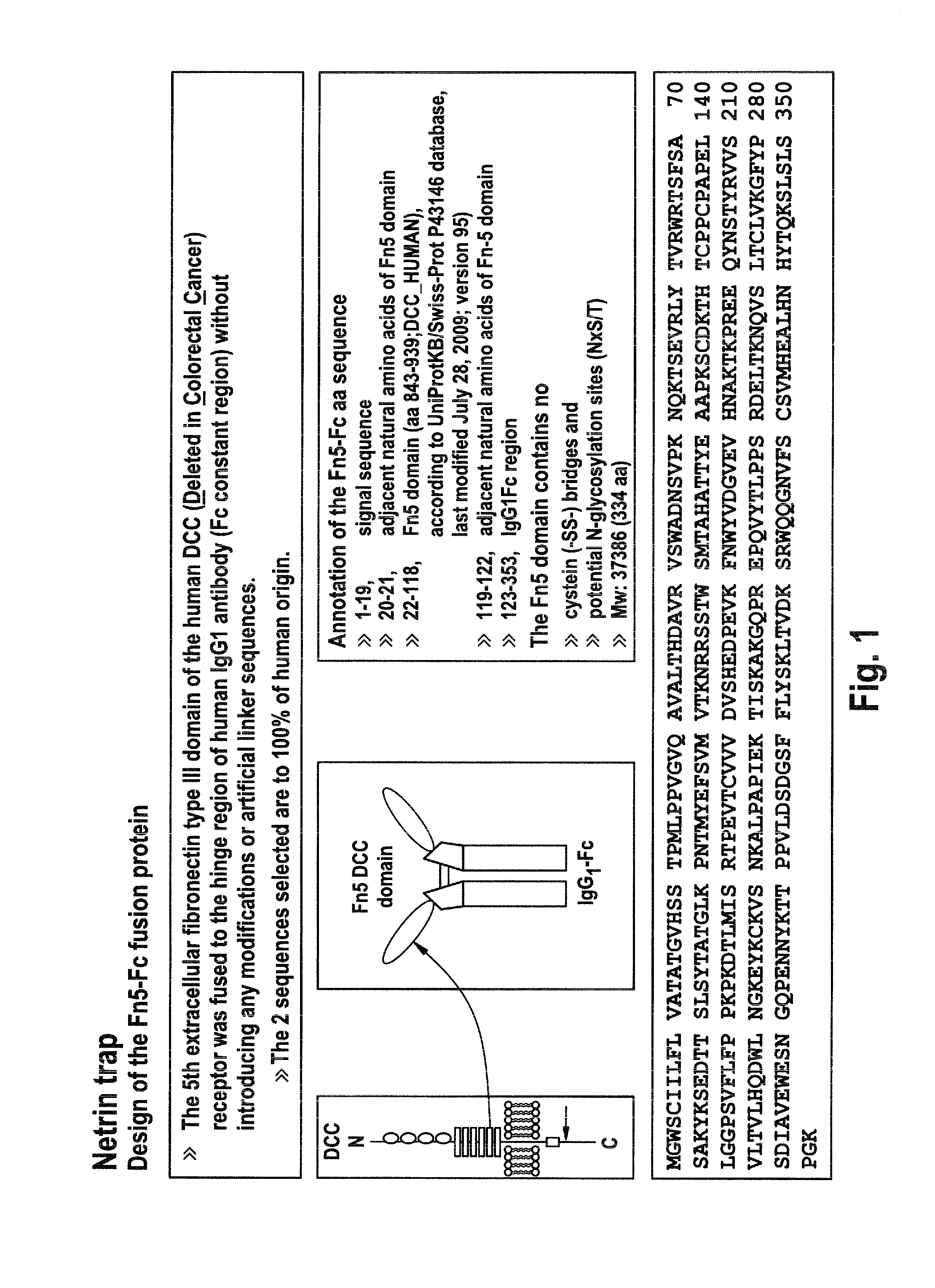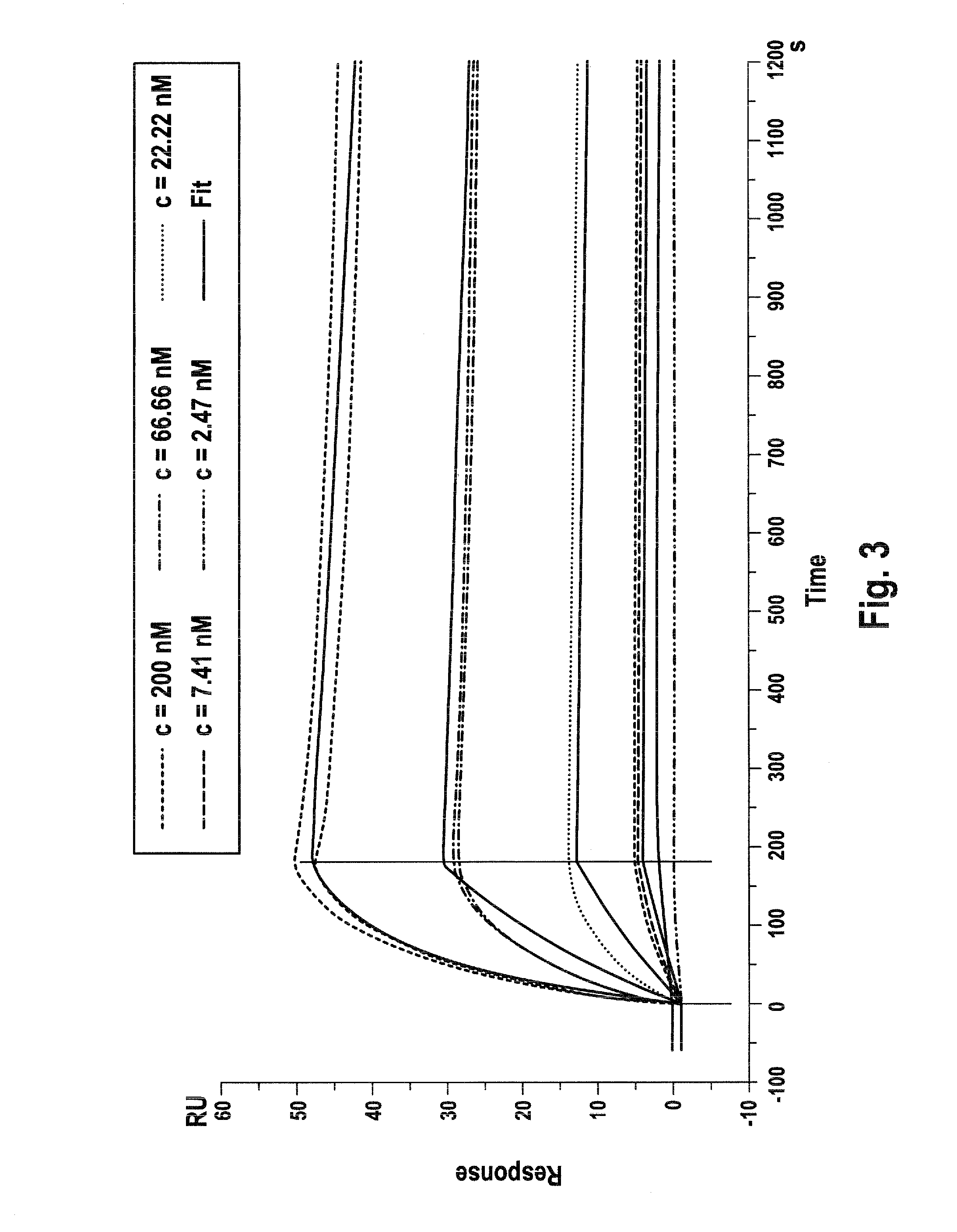Recombinant fc-fusion protein of the fifth fibronectin type iii domain of dcc
a technology of fibronectin and fusion protein, which is applied in the field of dccfusion protein, can solve the problems that dcc-5fbn-gst still bears several weaknesses, and achieve the effects of improving pharmacologic properties, high efficiency and better binding
- Summary
- Abstract
- Description
- Claims
- Application Information
AI Technical Summary
Benefits of technology
Problems solved by technology
Method used
Image
Examples
example 1
Fn5-Fc Fusion Proteins
Plasmid Construction
[0040]Standard methods were used to manipulate DNA as described in Sambrook, J. et al., Molecular cloning: A laboratory manual; Cold Spring Harbor Laboratory Press, Cold Spring Harbor, N.Y., 1989. The molecular biological reagents were used according to the manufacturer's instructions. Desired gene segments were prepared by gene synthesis. The synthesized gene fragments were cloned into a specified expression vector. The DNA sequence of the subcloned gene fragments were confirmed by DNA sequencing.
Expression Plasmid 7800
[0041]Vector 7800 is an expression plasmid e.g. for transient expression of an artificial Ig Fc fusion protein in which the fifth extracellular fibronectin type III domain of the human DCC (Deleted in Colorectal Cancer) receptor is fused to the hinge region of human IgG1 antibody (Fc constant region; Hinge-CH2-CH3) without introducing any modifications or artificial linker sequences; cf. FIG. 2.
[0042]A DNA segment of 1084 bps...
example 2
Transient Transfection and Expression
[0054]Recombinant proteins according to the invention as exemplified in Example 1 were obtained by transient transfection of HEK293-Freestyle cells (human embryonic kidney cell line 293, Invitrogen) growing in suspension. The transfected cells were cultivated in F17 medium (Gibco) or Freestyle 293 medium (Invitrogen), supplemented with 6 mM Glutamine, either Ultra-Glutamine (Biowhittake / Lonza) or L-Glutamine (Sigma), with 8% CO2 at 37° C. in shake flasks in the scale of 30 ml to 250 ml medium. For transfection Fectin (Invitrogen) was used in a ratio of reagent (μl) to DNA (μg) of 4:3. Polypeptides containing cell culture supernatants were harvested at day 6 to 8 after transfection. General information regarding the recombinant expression of human immunoglobulins in, e.g., HEK293 cells is given in: Meissner, P. et al., Biotechnol. Bioeng. 75 (2001) 197-203. The DCC-fusion protein (SEQ ID NO: 3) could be secreted with high efficiency at a rate of a...
example 3
Expression Analysis Using SDS-PAGE
[0055]LDS sample buffer, fourfold concentrate (4×LDS): 4 g glycerol, 0.682 g TRIS (tris-(hydroxymethyl)-aminomethane), 0.666 g TRIS-HCl (tris-(hydroxymethyl)-aminomethane-hydrochloride), 0.8 g LDS (lithium dodecyl sulfate), 0.006 g EDTA (ethylene diamin tetra acid), 0.75 ml of a 1% by weight (w / w) solution of Serva Blue G250 in water, 0.75 ml of a 1% by weight (w / w) solution of phenol red, add water to make a total volume of 10 ml.
[0056]The culture broths containing the secreted protein were centrifuged to remove cells and cell debris. An aliquot of the clarified supernatants were admixed with ¼ volumes (v / v) of 4×LDS sample buffer and 1 / 10 volume (v / v) of 0.5 M 1,4-dithiotreitol (DTT). Then the samples were incubated for 10 min. at 75° C. and protein separated by SDS-PAGE. The NuPAGE® Pre-Cast gel system (Invitrogen) was used according to the manufacturer's instruction. In particular, 10% NuPAGE® Novex® Bis-TRIS Pre-Cast gels (pH 6.4) and a NuPAGE®...
PUM
| Property | Measurement | Unit |
|---|---|---|
| concentrations | aaaaa | aaaaa |
| pH | aaaaa | aaaaa |
| pH | aaaaa | aaaaa |
Abstract
Description
Claims
Application Information
 Login to View More
Login to View More - R&D
- Intellectual Property
- Life Sciences
- Materials
- Tech Scout
- Unparalleled Data Quality
- Higher Quality Content
- 60% Fewer Hallucinations
Browse by: Latest US Patents, China's latest patents, Technical Efficacy Thesaurus, Application Domain, Technology Topic, Popular Technical Reports.
© 2025 PatSnap. All rights reserved.Legal|Privacy policy|Modern Slavery Act Transparency Statement|Sitemap|About US| Contact US: help@patsnap.com



